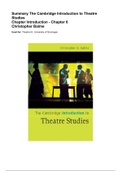Summary The Cambridge Introduction to Theatre
Studies
Chapter Introduction - Chapter 6
Christopher Balme
Used for: Theatre IA - University of Groningen
,Pages 1-15 (Introduction: theatre and theatre studies)
Theatre: from Greek theatron (a place for looking)
Term refers to a building (physical space), an activity (going/doing), an institution (the organization
that organizes the building/the plays), and an art (aesthetic) form
Areas of studying theatre: historical, aesthetic/theoretical, social/cultural
Basic idea: theatre demands the imaginative collusion of spectators and performers (essentially
role-playing) to function.
Now, also used for different purposes.
In studies: today, theatre studies has a strong focus on live performance, in all its artistic, cultural
and generic variety.
In Europe: the distinction between genres or forms is based on the activity of the central
performer, who predominantly speaks, sings, dances or mimes, or is non- human.
Most attention in theatre studies is paid to dramatic theatre. As a result, other genres such as
opera and dance are neglected. But, since the 1980s, a change occurred due to blending
boundaries in genres.
Main theatre forms
Dramatic theatre
Drama: originally a form of literature, but also used for spoken theatre/dramatic theatre (same)
From Greek: an action, and then a play for a stage
In this definition, employs exclusively or predominantly the spoken world. This means that another
spoken genres could be included as well (such as comedy and improvisational theatre)
Music theatre
Dominant form: the opera
High cultural status. Had the most economic support and occupied central functions of political
representation.
Musical competence is not innate. It requires special training and an acquaintance with a multitude
of conventions that can only be required over time.
Dance theatre
Best known: classical ballet
The moving body is now the dominant mode of expression.
Study of dance theatre is often linked to folklore studies, cultural anthropology or even sport.
However, dance can also be studied independently from any other studies, for example as a form
of expression.
Often used in Opera
Puppet and mask theatre
2D: shadow theatre
3D: live theatre which includes puppets, etc.
Can be children’s theatre, but also of high cultural status.
Around 1900: Modern puppet theatre emerges, especially in the avantgarde. Developed more
quickly after 1945.
A mask (Greeks used masks) has come to be a symbol of the medium and for many metaphors.
Each ascription has its own disciplinary pedigree: theatre as play is strongly influenced by
sociology and anthropology; theatre as communication by semiotics and communication theory;
theatre as energy exchange appears in more recent post-semiotic philosophy but is also discussed
in acting theory. On closer inspection, it becomes clear that a theatrical performance involves all
these elements.
, Pages 17-33 (Chapter 1: Performance and Actors)
Cross-culturally, there is a problem in defining what a performer is.
Anthropological precondition of acting: the human body
Approaches to acting:
- Theoretical and analytical
In contrast to drama, classical antiquity produced no theory of acting. There were a few works
produced, however, based on the rhetoric and public speaking.
Theory of Passions (until well into the seventeenth century): acting and public speaking
distinguished by three abilities:
1. To exercise emotional control over their bodies
2. To act on a wide physical space
3. To emotionally affect listeners sharing the same space
The emotions of the actor became the moral and philosophical problem. How can one’s own
emotions be separated from a character’s emotions? A lot of theories emerged around the subject,
such as Diderot’s Paradox of Acting.
- Historical and biographical
Nineteenth century: the rise of major stars and the spread of European theatre traditions to all
continents.
Delsarte (for pedagogical purposes, to systematize acting): emphasizes the interdependence of
body and emotion, in fact giving priority to physical movement over speech.
Twentieth century: three broad theoretical tendencies
- involvement (Stanislavsky): requires that the actor draws on his or her own emotional experience
(the so-called emotional or affective memory) to create a role. Conscious control. Has to take into
mind the super-objective: purpose of the whole play apart from the individual part.
Attempt to systematize the emotional/psychological (inner) and physical (outer) components of
acting. Stanislavsky emphasized the importance of balancing the physical and vocal aspects with
the emotional.
- detachment (Brecht; Meyerhold)
Brecht’s gestic acting: counter-model to Stanislavsky. Refers in the first instance to physical
movements that accompany speech. Gestures should be seen as supra-individual and thus
symptomatic of larger, social contexts. The actor’s relationship to his or her role is a detached one.
Leaves the spectator with a critical attitude towards the action on stage.
Actors should: perform in the third person, transpose the action into the past, and speak the stage
directions and commentaries.
Fundamental idea: emotions and thoughts are externalized as in traditional rhetoric.
Important: all body-oriented acting theories belong in the broadest sense to the ‘detachment'
school. Movement and gesture are the starting point for performance.
Meyerhold: theory of bio-mechanics —> mechanical laws of motion as developed in assembly-line
production could be applied to the human body. Actor should be guided by faith in a precise
performance technique.
- self-renunciation (Grotowski)
Relied heavily on Stanislavsky, but deeper focus on physical and psychological resources of the
actor. Acting is a communicative process with spectators. The central vehicle of theatrical action is
the human performer, above all the expressive means of body and mind, which can be drawn upon
to the point of total and utter self-renunciation.
Teaching of acting in a formal, institutionalized sense does not really begin on a wide scale until the
twentieth century. Before that, instruction took place ‘on the job’ through an informal apprentice






